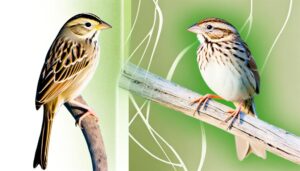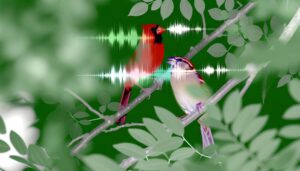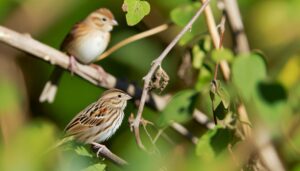5 Key Differences Between Female Red-Winged Blackbird vs Sparrow
The female Red-Winged Blackbird features an elongated silhouette and intricate streaky brown plumage, distinguishing it from the sparrow's simpler, uniform brown and gray coloration. Larger in size, Red-Winged Blackbirds measure 7 to 8.7 inches in length with a wingspan of 12 to 16 inches, compared to the sparrow's 5 to 7 inch length and 7.5 to 9.8 inch wingspan.
Habitat differences are also notable, with Red-Winged Blackbirds preferring wetlands and sparrows thriving in urban environments. Both species exhibit partial migratory behavior and dietary flexibility, yet their vocalizations and breeding habits are distinct.
Explore further nuances in their ecological roles and behaviors.
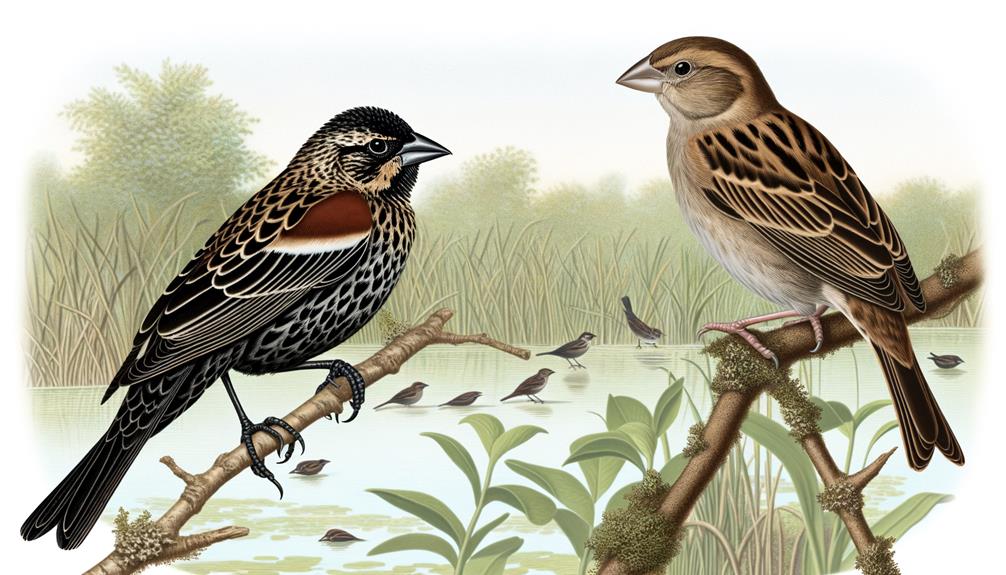
Key Takeaways
- Female Red-Winged Blackbirds have streaky brown plumage, while Sparrows have uniform brown or gray tones.
- Female Red-Winged Blackbirds are larger, with a length of 7 to 8.7 inches and a wingspan of 12 to 16 inches.
- Red-Winged Blackbirds inhabit wetlands and migrate to warmer climates, whereas Sparrows adapt to urban environments.
- Red-Winged Blackbirds build intricate nests in dense vegetation, while Sparrows often use man-made structures for nesting.
- Red-Winged Blackbirds have a complex vocal repertoire, while Sparrows mostly produce repetitive chirps.
Physical Appearance
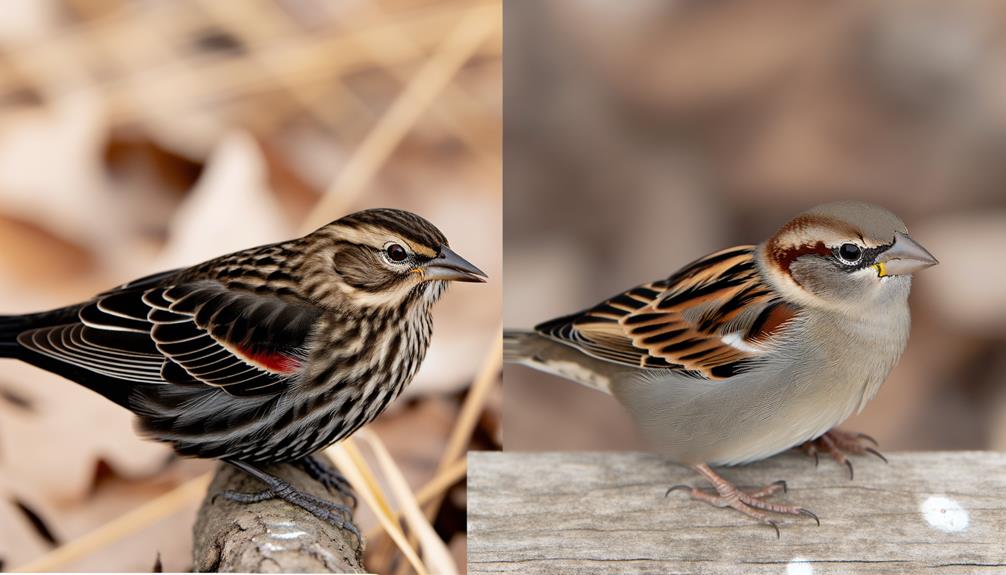
When comparing physical appearance, the female Red-Winged Blackbird sports a streaky brown plumage, while the sparrow typically exhibits a more uniform and muted brown or gray coloration. The female Red-Winged Blackbird's feathers are intricately patterned with streaks, providing effective camouflage in marshy environments.
Conversely, the sparrow's simpler, monotonous coloration aids in blending into urban and rural settings. Importantly, the female Red-Winged Blackbird has a more pronounced, elongated silhouette, enhanced by her distinct markings and slightly larger size. The sparrow, however, generally presents a compact, rounder form.
In both species, the beak structure differs significantly; the blackbird's beak is more conical and pointed, adapted for a varied diet, whereas the sparrow's beak is shorter and robust, suited for seed consumption.
Size Comparison
Size-wise, the female Red-Winged Blackbird typically measures between 7 to 8.7 inches in length, surpassing the smaller sparrow, which generally ranges from 5 to 7 inches. This size disparity gives the Red-Winged Blackbird a more commanding presence.
Additionally, the Red-Winged Blackbird's wingspan extends from 12 to 16 inches, eclipsing the sparrow's more modest 7.5 to 9.8 inches. The weight difference is also notable; the female Red-Winged Blackbird averages 1.3 to 2.8 ounces, whereas sparrows usually weigh between 0.8 to 1.4 ounces.
This larger size in the Red-Winged Blackbird contributes to its robust flight capabilities and broader territorial range. Overall, these measurements highlight the Red-Winged Blackbird's more substantial and imposing physical dimensions compared to the sparrow.
Plumage Patterns
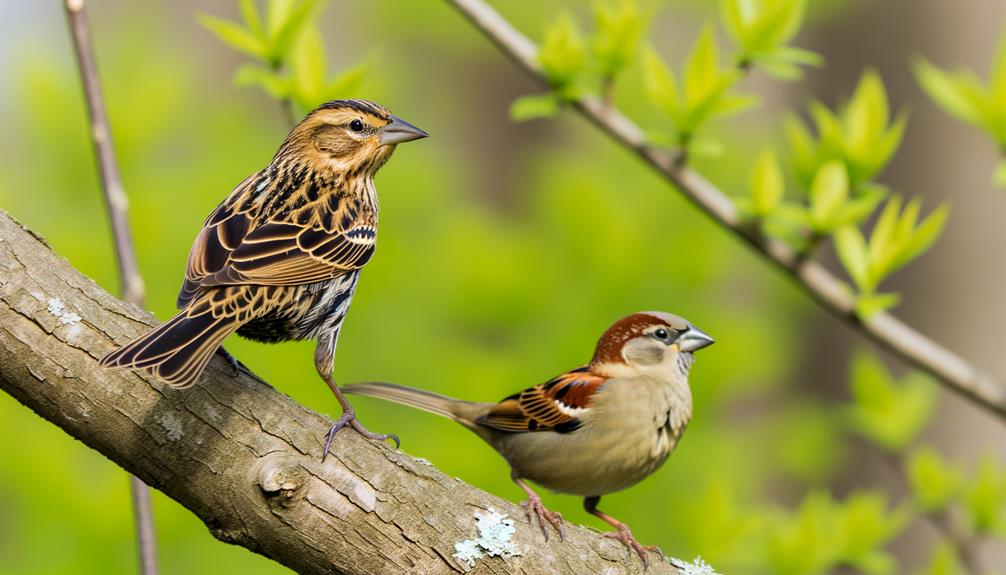
Female Red-winged Blackbirds exhibit streaked brown plumage with subtle hints of orange around the face, contrasting sharply with the more uniform brown and gray tones of female Sparrows.
Both species undergo seasonal changes in their feather patterns, but the Red-winged Blackbird's plumage remains relatively consistent throughout the year, whereas the Sparrow's becomes slightly duller during the winter months.
These distinctions in coloration and markings aid in species-specific identification and adaptive camouflage.
Coloration and Markings
Distinctive plumage patterns play an essential role in differentiating the female Red-winged Blackbird from the Sparrow. The former exhibits a streaked brown and buff coloration, providing camouflage in marshy habitats with a pronounced contrast between light and dark stripes. In contrast, the Sparrow often shows a more uniform, earthy brown plumage, offering a more consistent, muted tone that aids in blending into urban and rural environments.
The Red-winged Blackbird's facial markings include a light stripe over the eye, enhancing its distinctive appearance. On the other hand, Sparrows present subtler facial patterns, often with a soft, blurred effect. These coloration and markings serve as critical identifiers, aiding in species recognition and ecological interactions.
Seasonal Changes
Seasonal variations in plumage patterns reveal significant adaptations in both the Red-winged Blackbird and the Sparrow. The former undergoes subtle changes in hue and brightness to better blend with changing environments, with the female Red-winged Blackbird's plumage darkening slightly during the winter months, aiding in camouflage against bare landscapes. In contrast, Sparrows exhibit a stable plumage coloration, ensuring year-round recognition and social cohesion within flocks.
These adaptations underscore each species' unique approach to survival and environmental interaction.
- Camouflage Efficiency: Red-winged Blackbirds adapt to seasonal backgrounds.
- Social Dynamics: Consistent Sparrow plumage supports flock identification.
- Survival Strategies: Different plumage patterns highlight varied ecological niches.
Habitat Preferences
The female Red Winged Blackbird primarily occupies wetlands, exhibiting a strong preference for nesting in marshy areas with dense vegetation.
Conversely, the Sparrow adapts well to urban environments, often selecting nesting sites in human-made structures.
Both species demonstrate distinct seasonal migration patterns, with the Red Winged Blackbird migrating to warmer climates, while the Sparrow shows partial migratory behavior depending on the species.
Wetlands Vs. Urban Areas
Red-winged blackbirds mainly inhabit wetlands, exhibiting a strong preference for marshes and cattail-dense areas, whereas sparrows are more adaptable, often thriving in urban environments.
Wetlands offer red-winged blackbirds abundant resources, including insects and aquatic vegetation, essential for their diet and nesting. The dense vegetation also provides camouflage from predators.
In contrast, sparrows exhibit remarkable adaptability, exploiting urban areas where food sources such as seeds and insects are plentiful and diverse.
- Habitat Flexibility: Sparrows adapt to a variety of environments, from rural to urban settings.
- Resource Availability: Urban areas offer sparrows diverse food sources and nesting opportunities.
- Environmental Pressure: Wetlands provide red-winged blackbirds with protection and vital resources.
This comparative analysis highlights the specific habitat preferences driven by ecological needs.
Nesting Site Selection
Nesting site selection for female red-winged blackbirds and sparrows reflects their distinct ecological strategies and habitat preferences.
Female red-winged blackbirds prefer wetlands, constructing nests in dense vegetation near water bodies. They choose sites that offer concealment and protection from predators, often anchoring nests to cattails or reeds.
In contrast, female sparrows exhibit a broader habitat range, including urban areas, grasslands, and shrubby fields. They opt for sites like bushes, building eaves, or even abandoned nests. Sparrows' flexibility in nesting site selection allows them to exploit various environments, contributing to their widespread distribution.
This comparative analysis reveals how habitat preferences influence nesting behaviors, with red-winged blackbirds prioritizing specific wetland niches and sparrows capitalizing on diverse, adaptable nesting opportunities.
Seasonal Migration Patterns
Seasonal migration patterns reveal how female red-winged blackbirds and sparrows adapt their habitat preferences to changing environmental conditions. Red-winged blackbirds migrate southward during winter, favoring wetlands and marshes, while sparrows exhibit diverse migratory behaviors, often opting for urban and rural areas. This contrast highlights their different ecological adjustments.
Red-winged blackbird:
Utilizes wetland habitats, offering ample food and protection.
Sparrow:
Flexible migratory routes, often found in human-altered landscapes.
Habitat shift:
Both species adapt to temperature changes and food availability.
These migratory behaviors secure survival and reproductive success, demonstrating remarkable adaptability. Female red-winged blackbirds' preference for wetlands contrasts with sparrows' varied habitats, reflecting their unique evolutionary strategies. Understanding these patterns enhances our appreciation of avian resilience.
Feeding Habits
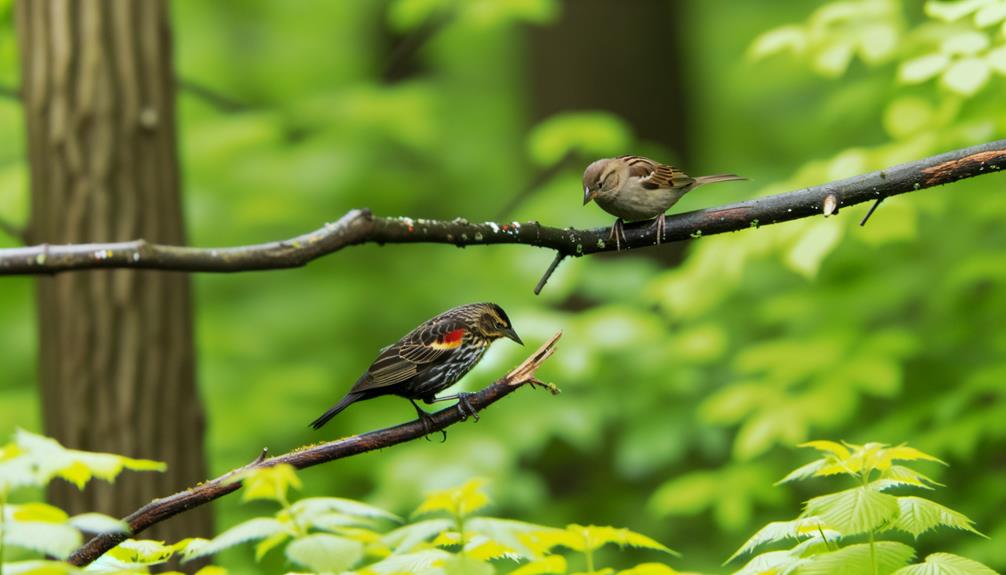
Feeding habits of the female Red-winged Blackbird and Sparrow exhibit distinct preferences and strategies, reflecting their adaptation to different ecological niches. The female Red-winged Blackbird primarily consumes insects during the breeding season, including beetles, caterpillars, and spiders, which provide essential protein for offspring development.
Outside the breeding season, they shift towards seeds and grains, showcasing their dietary flexibility.
Conversely, the female Sparrow, particularly the House Sparrow, exhibits a more granivorous diet. They primarily feed on seeds and grains year-round, occasionally supplementing their diet with insects and small invertebrates. This dietary consistency highlights their adaptation to urban and suburban environments where seeds are abundant.
Both species exemplify adaptive foraging strategies tailored to their respective habitats and seasonal requirements.
Breeding Behavior
Female Red-winged Blackbirds exhibit highly territorial breeding behaviors, often defending their nesting sites aggressively against intruders to secure reproductive success. These females demonstrate significant vigilance, frequently chasing away other birds that encroach upon their territory.
In contrast, female Sparrows adopt a more communal approach to breeding, often nesting in proximity to others and showing less aggression.
- Aggression Levels: Red-winged Blackbirds are significantly more combative.
- Territorial Range: Red-winged Blackbirds defend larger areas than Sparrows.
- Social Structure: Sparrows prefer communal nesting, showing higher social tolerance.
Through comparative analysis, these observations reveal the contrasting strategies in breeding behaviors between the two species. Red-winged Blackbirds emphasize territorial dominance, while Sparrows lean towards social tolerance and community living.
Nesting Sites
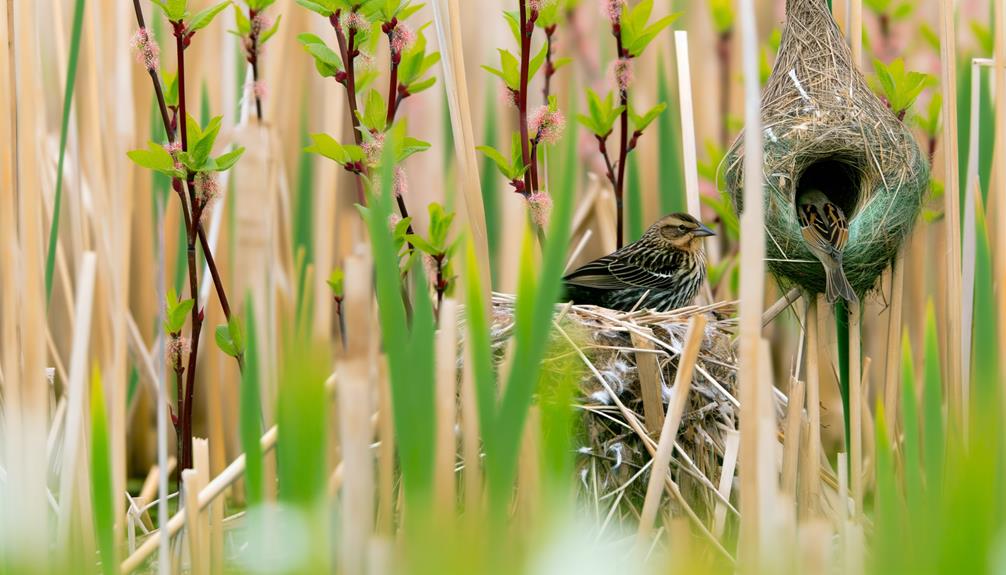
Red-winged Blackbirds typically choose marshy areas with dense vegetation for their nesting sites, contrasting sharply with Sparrows that prefer more open, urban, or suburban locations. These blackbirds construct nests amid cattails or reeds, ensuring concealment and protection from predators. Their nests are intricately woven and anchored to sturdy plant stalks.
On the other hand, Sparrows exhibit a remarkable adaptability, opting for ledges, eaves, and even man-made structures for nesting. They use materials like grass, twigs, and feathers to assemble their nests in less concealed areas. This divergent nesting behavior highlights their unique survival strategies.
Where Red-winged Blackbirds rely on natural camouflage and water proximity, Sparrows capitalize on proximity to human habitation and readily available nesting materials.
Vocalizations
When it comes to vocalizations, Red-winged Blackbirds exhibit a more complex and varied repertoire compared to the simpler, repetitive chirps of Sparrows.
The female Red-winged Blackbird produces a series of sharp, metallic calls that serve various functions, such as territory defense and mate attraction. In contrast, the female Sparrow's vocalizations are less diverse, primarily consisting of consistent, high-pitched chirps.
Red-winged Blackbirds use different calls for alarm, mating, and communication. Sparrows rely on repetitive chirps to maintain flock cohesion. Red-winged Blackbirds' calls can change based on environmental factors.
Detailed observations reveal that Red-winged Blackbirds possess a wider range of vocal expressions, demonstrating a higher level of acoustic complexity. This diversity underscores their advanced communication strategies compared to the more uniform vocal patterns of Sparrows.
Migration Patterns
While their vocalizations reveal distinct behavioral adaptations, the migration patterns of Red-winged Blackbirds and Sparrows further distinguish these species. Red-winged Blackbirds exhibit partial migratory behavior; females often journey farther south compared to males, seeking warmer climates in the southern United States.
In contrast, Sparrows, particularly the Song Sparrow, display more varied migratory habits. Some populations remain resident year-round, while others migrate short distances, influenced by geographic location and environmental conditions.
Detailed observations reveal that Red-winged Blackbirds migrate in large flocks, providing safety in numbers. Sparrows, however, tend to migrate in smaller groups or even alone, showcasing their adaptability.
This comparative analysis highlights the diverse strategies these species employ to navigate changing seasons and ensure their survival.
Predation and Defense
Female Red-winged Blackbirds and Sparrows exhibit distinct defense mechanisms to counteract predation. Red-winged Blackbirds utilize aggressive mobbing behaviors and loud alarm calls to deter predators, whereas Sparrows often rely on camouflage and rapid flight to escape threats.
Both species encounter common predators such as hawks and domestic cats, yet their divergent strategies reflect adaptations to their respective ecological niches.
Natural Defense Mechanisms
Red-winged blackbirds employ aggressive mobbing tactics to fend off predators, whereas sparrows rely more on camouflage and swift flight to escape threats. Female red-winged blackbirds, often seen in dense marshes, use coordinated group attacks to intimidate intruders, showcasing their communal defense strategy.
Conversely, female sparrows, with their earth-toned plumage, blend seamlessly into their surroundings, making detection by predators challenging.
- Mobbing: Red-winged blackbirds swarm predators, using sheer numbers to deter.
- Camouflage: Sparrows' coloration provides natural concealment in various habitats.
- Flight agility: Sparrows exhibit rapid, erratic flight patterns to evade capture.
This comparative analysis highlights distinct evolutionary adaptations in these species, reflecting their unique environmental pressures and survival strategies. These behaviors underscore the varied approaches to predation and defense in avian species.
Common Predators Encountered
Both red-winged blackbirds and sparrows face threats from a variety of predators, including raptors, snakes, and mammals. Each necessitates specific defensive tactics to enhance their survival.
Red-winged blackbirds, frequenting wetlands, are often targeted by raptors like hawks and owls. They employ distraction displays and mobbing behaviors to deter predators.
Conversely, sparrows, inhabiting urban and rural areas, encounter threats from domestic cats and snakes. Sparrows utilize rapid flight and camouflage to escape detection.
Females of both species exhibit heightened vigilance during nesting periods. While red-winged blackbirds rely on aggressive defense and communal nesting, sparrows depend on cryptic coloration and strategic nest placement.
This comparative analysis highlights their adaptive strategies, driven by predator type and environmental context.
Role in Ecosystem

Regarding their roles in the ecosystem, the female red-winged blackbird and sparrow contribute significantly to insect population control and seed dispersion, respectively.
The female red-winged blackbird consumes a variety of insects during the breeding season, effectively reducing pest populations. Pest Control: Female red-winged blackbirds consume caterpillars, beetles, and other agricultural pests.
In contrast, sparrows primarily feed on seeds, aiding in the dispersal of plant species and promoting vegetation growth. Seed Dispersion: Sparrows transport seeds across various terrains, fostering plant diversity.
Ecological Balance: Both species play pivotal roles in maintaining the balance between different trophic levels.
Their distinct feeding habits underline their complementary contributions, ensuring the stability and productivity of their shared habitats.
Conclusion
In a perplexing twist of avian drama, the female red-winged blackbird struts her stuff with bold plumage and assertive vocalizations, making the humble sparrow look like a drab wallflower at nature's grand ball.
While the sparrow's modest size and understated charm serve it well in various habitats, it can't quite compete with the red-winged blackbird's flair for the dramatic.
Ultimately, both birds play essential roles in their ecosystems, but let's face it, one's clearly got more stage presence.

